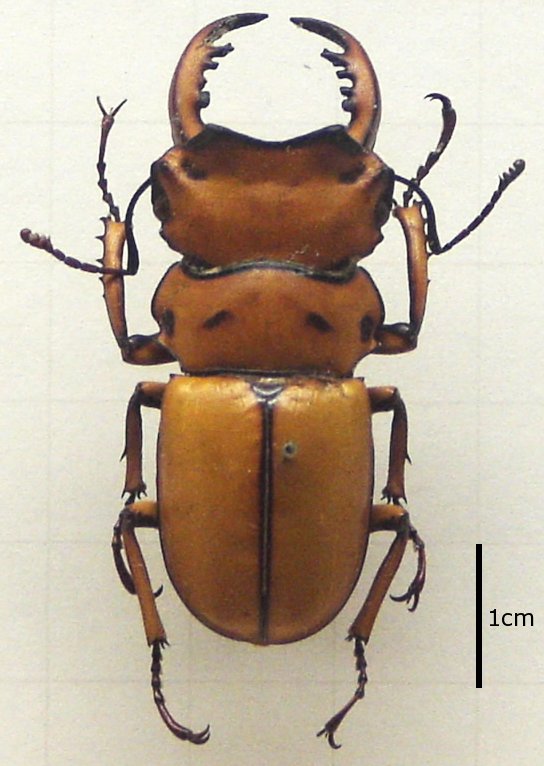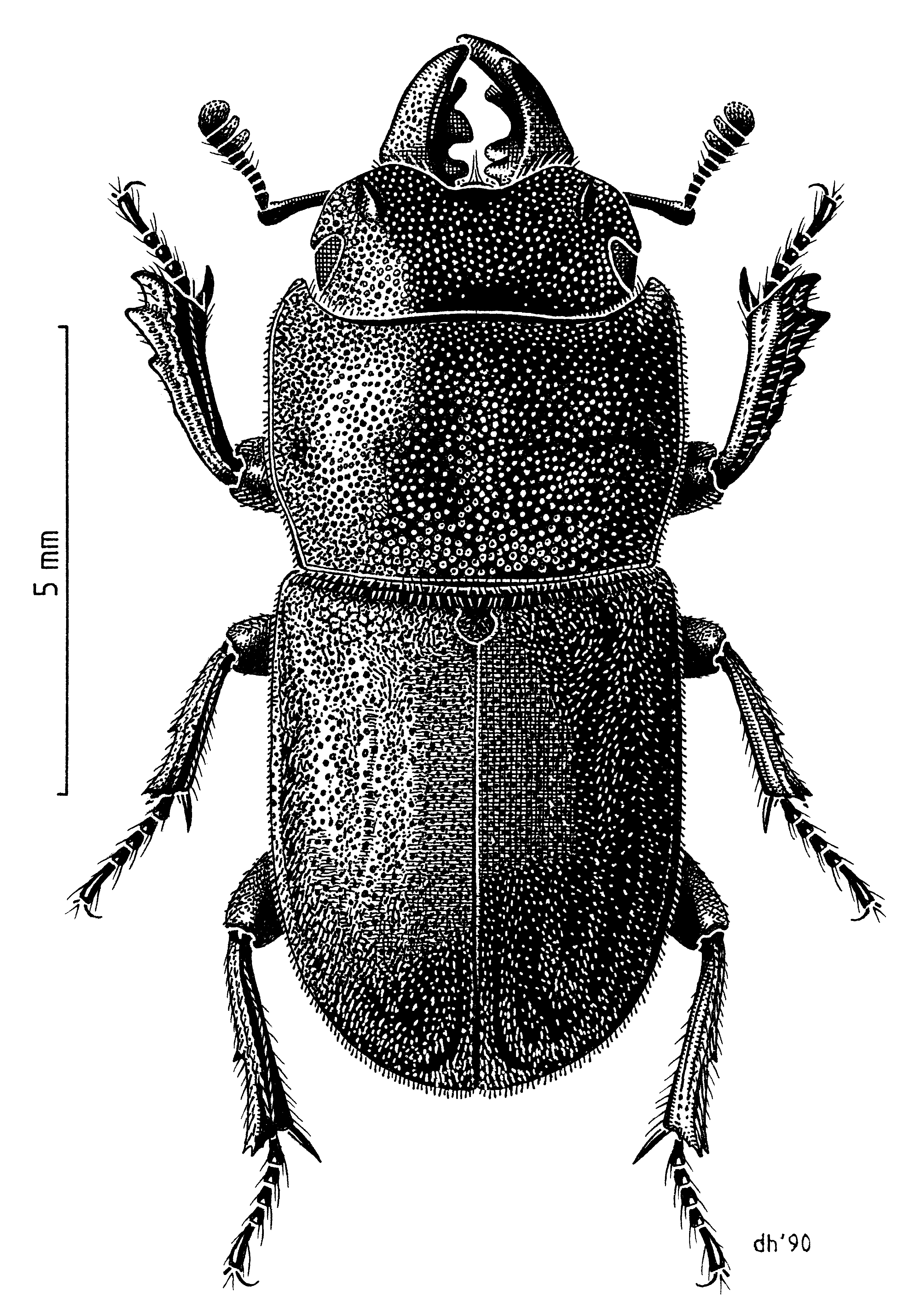|
Chiasognathus Sombrus
''Chiasognathus sombrus'' is a beetle which belongs to the family of stag beetles (Lucanidae) in the group Scarabaeoidea. Appearance A medium-sized (22-28 millimeter), long-legged, semi-matt, brown stag beetle. The body is short and wide. The pronotum has a bronze-like metallic lustre, and has a small spike at the back corner, in this species it is almost without hair except as a brim along the edge. The legs are slender, the legs (tibiae) with pointed thorns. The jaws of the male are relatively short, knife-shaped, bent down and inwardly bent at the end. The inner edge has a pair of teeth. The head is relatively small, the antennae have a long, thin shaft but no striking fan. The males have four clearly separated, round eyes, one pair sitting on the upper side of the jaws and one on the lower side. The cover wings are quite short and wide, without pointed rows. The legs are quite long, especially the front legs. The females lack the males' greatly enlarged jaws, although t ... [...More Info...] [...Related Items...] OR: [Wikipedia] [Google] [Baidu] |
Beetle
Beetles are insects that form the order Coleoptera (), in the superorder Endopterygota. Their front pair of wings are hardened into wing-cases, elytra, distinguishing them from most other insects. The Coleoptera, with about 400,000 described species, is the largest of all orders, constituting almost 40% of described insects and 25% of all known animal life-forms; new species are discovered frequently, with estimates suggesting that there are between 0.9 and 2.1 million total species. Found in almost every habitat except the sea and the polar regions, they interact with their ecosystems in several ways: beetles often feed on plants and fungi, break down animal and plant debris, and eat other invertebrates. Some species are serious agricultural pests, such as the Colorado potato beetle, while others such as Coccinellidae (ladybirds or ladybugs) eat aphids, scale insects, thrips, and other plant-sucking insects that damage crops. Beetles typically have a particularly hard e ... [...More Info...] [...Related Items...] OR: [Wikipedia] [Google] [Baidu] |
Stag Beetle
Stag beetles are a family of about 1,200 species of beetles in the family Lucanidae, currently classified in four subfamilies.Smith, A.B.T. (2006). A review of the family-group names for the superfamily Scarabaeoidea (Coleoptera) with corrections to nomenclature and a current classification. The Coleopterists Bulletin 60:144–204. Some species grow to over , but most to about . Overview The English name is derived from the large and distinctive mandibles found on the males of most species, which resemble the antlers of stags. A well-known species in much of Europe is ''Lucanus cervus'', referred to in some European countries (including the United Kingdom) as ''the'' stag beetle; it is the largest terrestrial insect in Europe. Pliny the Elder noted that Nigidius called the beetle ''lucanus'' after the Italian region of Lucania where they were used as amulets. The scientific name of ''Lucanus cervus'' adds ''cervus'', deer. Male stag beetles are known for their oversize mandi ... [...More Info...] [...Related Items...] OR: [Wikipedia] [Google] [Baidu] |
Beetles Of South America
Beetles are insects that form the order Coleoptera (), in the superorder Endopterygota. Their front pair of wings are hardened into wing-cases, elytra, distinguishing them from most other insects. The Coleoptera, with about 400,000 described species, is the largest of all orders, constituting almost 40% of described insects and 25% of all known animal life-forms; new species are discovered frequently, with estimates suggesting that there are between 0.9 and 2.1 million total species. Found in almost every habitat except the sea and the polar regions, they interact with their ecosystems in several ways: beetles often feed on plants and fungi, break down animal and plant debris, and eat other invertebrates. Some species are serious agricultural pests, such as the Colorado potato beetle, while others such as Coccinellidae (ladybirds or ladybugs) eat aphids, scale insects, thrips, and other plant-sucking insects that damage crops. Beetles typically have a particularly hard exoske ... [...More Info...] [...Related Items...] OR: [Wikipedia] [Google] [Baidu] |
Beetles Described In 2010
Beetles are insects that form the order Coleoptera (), in the superorder Endopterygota. Their front pair of wings are hardened into wing-cases, elytra, distinguishing them from most other insects. The Coleoptera, with about 400,000 described species, is the largest of all orders, constituting almost 40% of described insects and 25% of all known animal life-forms; new species are discovered frequently, with estimates suggesting that there are between 0.9 and 2.1 million total species. Found in almost every habitat except the sea and the polar regions, they interact with their ecosystems in several ways: beetles often feed on plants and fungi, break down animal and plant debris, and eat other invertebrates. Some species are serious agricultural pests, such as the Colorado potato beetle, while others such as Coccinellidae (ladybirds or ladybugs) eat aphids, scale insects, thrips, and other plant-sucking insects that damage crops. Beetles typically have a particularly har ... [...More Info...] [...Related Items...] OR: [Wikipedia] [Google] [Baidu] |
Chiasognathus
''Chiasognathus'' is a genus of stag beetles found in Argentina and Chile. It includes seven species: *''Chiasognathus beneshi'' Lacroix, 1978 *''Chiasognathus grantii'' Stephens, 1832 *''Chiasognathus impubis'' Parry, 1870 *''Chiasognathus jousselinii'' Reiche, 1850 *''Chiasognathus latreillei'' Solier, 1851 *''Chiasognathus mniszechii ''Chiasognathus'' is a genus of stag beetles found in Argentina and Chile. It includes seven species: *''Chiasognathus beneshi'' Lacroix, 1978 *''Chiasognathus grantii'' Stephens, 1832 *''Chiasognathus impubis'' Parry, 1870 *''Chiasognathus jo ...'' Thomson, 1862 *'' Chiasognathus sombrus'' Paulsen & Smith, 2010 References External links * Lucaninae Beetles of South America Lucanidae genera {{Lucanidae-stub ... [...More Info...] [...Related Items...] OR: [Wikipedia] [Google] [Baidu] |
Lucaninae
The Lucaninae comprise the largest subfamily of the stag beetles (Lucanidae). Characteristics include partial to complete division of the eyes by a canthus, geniculate antennae, and distinctly separated coxae. The body is typically elongated and slightly flattened. Genera Some notable species are also listed: * '' Aegognathus'' * '' Aegus'' * '' Agnus'' * '' Allotopus'' * '' Amneidus'' * '' Andinolucanus'' * '' Aphanognathus'' * '' Apterocyclus'' * '' Apterodorcus'' Arrow, 1943 * '' Auxicerus'' * '' Bartolozziolucanus'' * '' Beneshius'' * '' Bomansius'' * '' Brasilucanus'' * '' Cacostomus'' ** '' C. squamosus'' * '' Calcodes'' * '' Cantharolethrus'' ** '' C. luxeri'' * '' Capreolucanus'' * ''Cardanus'' * '' Casignetus'' * '' Charagmophorus'' * '' Chewlucanus'' * '' Chiasognathus'' * '' Cladophyllus'' * '' Cladognathus'' * '' Colophon'' * '' Cyclommatus'' ** '' C. scutellaris'' * '' Dendezia'' * '' Diasomoides'' * '' Dinonigidius'' * '' Dorculus'' * '' Dorcus'' * '' Dynod ... [...More Info...] [...Related Items...] OR: [Wikipedia] [Google] [Baidu] |
Lucanidae
Stag beetles are a family of about 1,200 species of beetles in the family Lucanidae, currently classified in four subfamilies.Smith, A.B.T. (2006). A review of the family-group names for the superfamily Scarabaeoidea (Coleoptera) with corrections to nomenclature and a current classification. The Coleopterists Bulletin 60:144–204. Some species grow to over , but most to about . Overview The English name is derived from the large and distinctive mandibles found on the males of most species, which resemble the antlers of stags. A well-known species in much of Europe is ''Lucanus cervus'', referred to in some European countries (including the United Kingdom) as ''the'' stag beetle; it is the largest terrestrial insect in Europe. Pliny the Elder noted that Nigidius called the beetle ''lucanus'' after the Italian region of Lucania where they were used as amulets. The scientific name of ''Lucanus cervus'' adds ''cervus'', deer. Male stag beetles are known for their oversize mandi ... [...More Info...] [...Related Items...] OR: [Wikipedia] [Google] [Baidu] |
Scarabaeidae
The family Scarabaeidae, as currently defined, consists of over 30,000 species of beetles worldwide; they are often called scarabs or scarab beetles. The classification of this family has undergone significant change in recent years. Several subfamilies have been elevated to family rank (e.g., Bolboceratidae, Geotrupidae, Glaresidae, Glaphyridae, Hybosoridae, Ochodaeidae, and Pleocomidae), and some reduced to lower ranks. The subfamilies listed in this article are in accordance with those in Bouchard (2011). Description Scarabs are stout-bodied beetles, many with bright metallic colours, measuring between . They have distinctive, clubbed antennae composed of plates called lamellae that can be compressed into a ball or fanned out like leaves to sense odours. Many species are fossorial, with legs adapted for digging. In some groups males (and sometimes females) have prominent horns on the head and/or pronotum to fight over mates or resources. The largest fossil scaraba ... [...More Info...] [...Related Items...] OR: [Wikipedia] [Google] [Baidu] |
Stag Beetle
Stag beetles are a family of about 1,200 species of beetles in the family Lucanidae, currently classified in four subfamilies.Smith, A.B.T. (2006). A review of the family-group names for the superfamily Scarabaeoidea (Coleoptera) with corrections to nomenclature and a current classification. The Coleopterists Bulletin 60:144–204. Some species grow to over , but most to about . Overview The English name is derived from the large and distinctive mandibles found on the males of most species, which resemble the antlers of stags. A well-known species in much of Europe is ''Lucanus cervus'', referred to in some European countries (including the United Kingdom) as ''the'' stag beetle; it is the largest terrestrial insect in Europe. Pliny the Elder noted that Nigidius called the beetle ''lucanus'' after the Italian region of Lucania where they were used as amulets. The scientific name of ''Lucanus cervus'' adds ''cervus'', deer. Male stag beetles are known for their oversize mandi ... [...More Info...] [...Related Items...] OR: [Wikipedia] [Google] [Baidu] |
Polyphaga
Polyphaga is the largest and most diverse suborder of beetles. It comprises 144 families in 16 superfamilies, and displays an enormous variety of specialization and adaptation, with over 350,000 described species, or approximately 90% of the beetle species so far discovered. Key characteristics of Polyphaga are that the hind coxa (base of the leg) does not divide the first and second abdominal/ventral plates which are known as sternites. Also, the notopleural suture (found under the pronotal shield) is not present. Etymology The name of ''polyphaga'' is derived from two Greek words: , meaning 'many', and , meaning 'to eat', so the suborder is called the “eaters of many things”. Classification The five main infraorders are: * Bostrichiformia — including furniture beetles and skin beetles * Cucujiformia — includes lady beetles, longhorn beetles, weevils, checkered beetles and leaf beetles * Elateriformia — includes click beetles and fireflies * Scarabaeiformia — ... [...More Info...] [...Related Items...] OR: [Wikipedia] [Google] [Baidu] |





